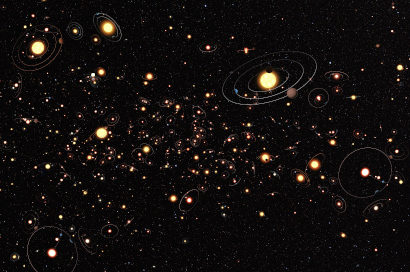- Series:Astronomy, Transcript English
Psalm 8:1
“O LORD our Lord, how excellent is thy name in all the earth! who hast set thy glory above the heavens.”
 There are phrases which can be used in science articles which will immediately pique interest, or at least convey some information about contemporary scientific viewpoints. An example of this was a recent article from a popular-level science website which referred to planetary ‘missing links’. As earth-style exo-planets have been all the rage lately, one might suppose that the use of the phrase ‘missing link’ might refer to astronomers’ belief in the evolution of life on such worlds. However, the sort of evolution to which the article referred was the supposed evolution of actual planets.
There are phrases which can be used in science articles which will immediately pique interest, or at least convey some information about contemporary scientific viewpoints. An example of this was a recent article from a popular-level science website which referred to planetary ‘missing links’. As earth-style exo-planets have been all the rage lately, one might suppose that the use of the phrase ‘missing link’ might refer to astronomers’ belief in the evolution of life on such worlds. However, the sort of evolution to which the article referred was the supposed evolution of actual planets.
The smallest gas giant planet in our Solar System is Neptune, while the largest rocky planet is our own Earth. A star 73 million light years away, which rejoices in the name TOI-270, seems to have three planets. I say “seems to have” because exo-planets are not seen through telescopes. Their existence is inferred, and their positions and size calculated from perturbations in movement and light intensity of their host stars. Nevertheless, the math is sound and likely to be correct – I just don’t want listeners to think that these planets have been seen. One of the planets would seem to be a rocky planet larger than the Earth, while the other two are gas giants, about half the size of Neptune. So speculation is growing over whether all of these planets could have “evolved” in the same way. As usual, secular scientists do not give God the honor or the glory for His wonderful creation.
Prayer: We are amazed, Lord, at the size and diversity of Your creativity throughout the universe, and it causes us to praise Your Name. Amen.
Author: Paul F. Taylor
Ref: Massachusetts Institute of Technology. “TESS discovers three new planets nearby, including temperate ‘sub-Neptune’: Planetary system orbiting an unusually quiet star is ideal for future habitability searches.” ScienceDaily, 29 July 2019. <www.sciencedaily.com/releases/2019/07/190729111328.htm>. Image: Artist’s Impression, ESO, CC BY-SA 4.0 International.
© 2020 Creation Moments. All rights reserved.
